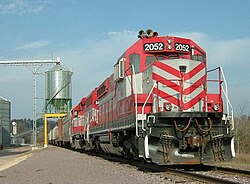
The SD20 is the product of a rebuilding program by the Illinois Central Gulf's Paducah Shops as a conversion from the EMD SD7, EMD SD24, SD24B (cabless), and EMD SD35 locomotives. The program involved rebuilding the 567 engine to 645E with 2000 horsepower rating, eliminating the turbocharger if equipped with one, upgrading the electronics to Dash 2 technology, and adding cabs to the B units. A total of 42 units were rebuilt. Original heritage of the rebuilt units was 3 Union Pacific SD7s, 4 Union Pacific SD24s, 10 Union Pacific SD24Bs, 21 Southern SD24s, and 4 Baltimore and Ohio SD35s. Many of the units to be rebuilt were purchased from Precision National. Three of the ex-Southern SD24s wore Precision reporting marks. The locomotives were rebuilt between August 1979 and December 1982. Road Numbers assigned were 2000–2041. Unit 2041 was the last Paducah rebuild.